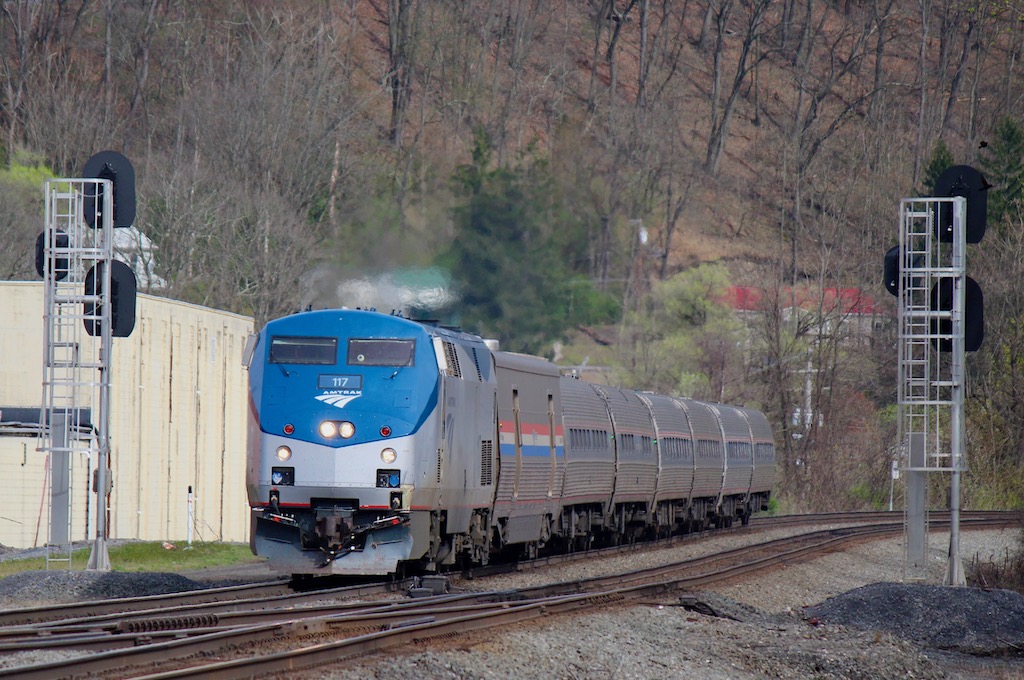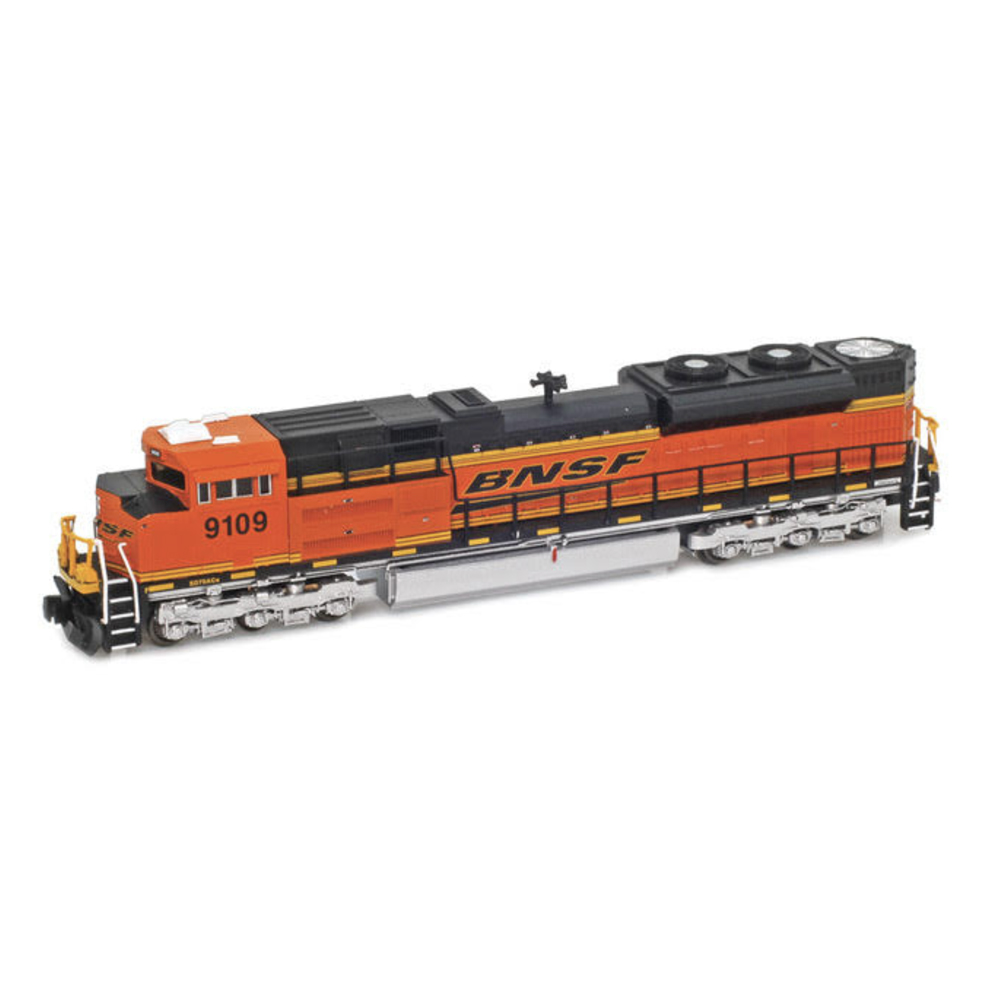
Railroads have what you could call a one-train problem. That is to say they offer but one daily departure from Point A to Point B.
A case in point is Amtrak’s Pennsylvanian, which links New York City and Pittsburgh.
Earlier this month I wanted to ride Amtrak to a rail shippers conference in the Steel City. I’m blessed to live in Western Massachusetts, where we are well connected to the Northeast Corridor. From Springfield Union Station you can catch Amtrak’s Valley Flyer or CTrail commuter service to New Haven and a cross-platform connection to Acela Express, Northeast Regional, or Metro-North trains to the Big Apple and beyond. Or for a one-seat trip you can take the Vermonter or our lone inland-route Northeast Regional train.
But good luck trying to get to Pittsburgh. If you’re willing to get up at oh-dark-thirty you can catch 5:10 a.m. or 5:45 a.m. trains from Springfield to New York Penn Station. I don’t like losing shuteye. And I suspect other potential passengers are put off by having to get up before sunrise only to have to linger at Penn Station for an hour or two to wait for the once-daily Pennsylvanian’s 10:52 a.m. departure.
If you want to travel at a more civilized hour, technically it’s possible to catch the 7:05 a.m. Valley Flyer No. 471 from Springfield to New Haven and Northeast Regional No. 171 from New Haven for a 10:22 a.m. arrival at New York Penn. Possible, yes. Advisable? Well, no. If the Springfield-New York trains are on time you’d have a scant 30 minutes to make the connection. I asked our Amtrak man, Bob Johnston, if he’d book this trip. It took a millisecond for him to say no way, noting that Amtrak’s online ticketing system won’t even let you book a trip with such a tight connection.
So as I type this I am sorry to say that I am aboard Southwest flight 237 to Pittsburgh. I’d much rather be rounding Horseshoe Curve on train 43.
The one-train problem proved to be an insurmountable barrier. And you have to wonder how many other people living near God knows how many Amtrak stations remain would-be passengers — instead of paying customers — simply because there’s just one daily train from here to there. And there are a lot of them. Think of any train with a name, from Adirondack to Vermonter, and it departs once a day in each direction at a time that may or may not be convenient.
This isn’t just a passenger issue. Like Amtrak in many locations, the Class I railroads typically offer a single daily departure between intermodal terminals. The impact is a bigger deal in the East than the West because of length of haul. In the East, a container may spend as much time sitting in terminals as it does riding the train between terminals. The total dwell of 24 hours can be the primary consideration that ultimately pushes loads to the roads.

The solution to the one-train problem is obvious: Add a second departure. That way if you don’t make the connection or your container misses the train the delay is measured in hours, not days. It also gives passengers or shippers more options and flexibility, which only increases the likelihood that they decide to use the train.
Fortunately Amtrak and Norfolk Southern this year inked a deal to launch a second Pennsylvanian once $200 million in state-funded capital improvements put more iron in the ground between Harrisburg and Pittsburgh. Amtrak’s Connects US expansion plan proposes more frequent service in several corridors, too. (I don’t put much faith in this given Amtrak’s spotty expansion record, host railroad opposition to more passenger trains, and questions about the level of state support. But that’s a topic for another day.)
On the freight side, give NS credit for adding a second daily departure in its key Chicago-Atlanta intermodal lane over the summer. This can cut terminal dwell in half, effectively shaving as much as 12 hours off ingate to outgate transit time. It’s a simple service improvement that will enable NS to gain more intermodal volume while helping customers improve their box turn times.
But there needs to be a lot more of this. When people say they’re taking the train it shouldn’t literally mean the one and only train.
You can reach Bill Stephens at bybillstephens@gmail.com and follow him on LinkedIn and Twitter @bybillstephens














How about this thought there is no North or South passenger service other then the east coast , not the central part of the country think back on the Delaware & Hudson railroad had passenger service from upstate NY. down to and thru PA. and other points . It would be great if Amtrack or private Invester started a passenger service on the former D&H Railroad line in upstate NY. that the Norfolk & Southern now own and run, just think how neat it would be taking a train to Coppers Town NY. visit the baseball hall of fame , Binghamton NY. Scranton PA. Harrisburg PA./ Amish area , without wasting time and money going southeast to go thru NYC. and then back out West . Its just an thought but it just might work!
Not so sure that 1/day for freight is a problem – because the end-point gathering and distribution is with a bulletined local or switch engine – and they typically go to each station or industry once per day. Have seen that pattern every place I have worked.
The important item is running manifest trains on schedule, rather than Holding For Tonnage. Right car – right train – on-time departure.
Obviously as important for intermodal, and it generally works there. Same can be done with Manifest. I have seen it.
The real difference between freight and passenger is that Wall Street will not allow the Class 1s to deteriorate into oblivion to the detriment of transporting the critical components through the supply chain. Even before, for example, when Robert Young’s investment in the NYC was threatened, he brought in after Korea a proven quantity in Alfred Perlman who had turned around the DRG&W.
In Amtrak’s beginning, Congress and DOT were fortunate to have proven reserves to call upon in Reistrup, Claytor, and Gunn. However, that talent with a penchant and passion for knowing how to schedule and operate passenger trains is long gone, and not coming back.
Nobody in power cares; the lack of a sophisticated, knowledgeable Secretary of Transportation clearly reflects upon the pathetic leadership ensconced at Amtrak. If Batory had still been running FRA he would have never tolerated the “Sid Caesar Hour” of an ineffectual Board and inexperienced corporate management making such ruinous decisions re Amtrak’s operations in the pandemic. Indeed, this is what it must be like to be in Putin’s boots to wonder why his generals cannot win, despite their lack of a coherent strategy, competently trained, motivated, and supplied troops.
Reistrup understood frequency; Claytor was knowledgeable on the ingredients that created good service; Gunn knew operations. Who at Amtrak today in corporate management or the Board can hang their hat on any of those points? Knowing the inability of Amtrak to fill those shoes is probably why nobody in Congress bothers anymore. In the eyes of Congress and the media, the Andrea Doria has already sailed; no turning back.
Back in the olden days, there were many freights from Chicago, either Alphabet Route or Central States Dispatch, BUT unless you were in a terminal district, the boxcar got to your loading dock on the daily local freight. So there’s your ONE freight a day. And the true hotshots were due in the wee hours so your boxcar could get pulled, transferred and put in your local freight that day.
Four years ago a group I belong to based out of Cleveland met to plan a trip to Conway, NH, to climb Mt. Washington. The consensus of the group was to take Amtrak from Cleveland to Boston and rent several cars there. Being an Amtrak employee I volunteered to do the legwork and let the group know what I could come up with. All said and done all but one drove. And he flew to Portland and rented a car. Train 48 gets to Worcester and Boston too late to make it work. I looked at other alternatives. None would work round trip. All because it’s one train each way per day. Bob is correct in asking how many others who want to use the train don’t because of the lack of service.
I too would like to see more passenger service in central Texas. But the numbers don’t support it.
Let’s use 2019 numbers, since they are pre-pandemic and are more reflective of what was happening before the onset of Covid-19.
The Pennsylvanian, which I have ridden several times to and from my hometown of Altoona, had an average load factor of 53% and incurred an operating loss of $2.3 million.
The Pacific Surfliners, which have numerous frequencies, had an average load factor of 30% and racked up a combined operating loss of $17.3 million.
The Hiawatha’s had an average load factor of 41% and incurred an operating loss of $1.3 million.
The long-distance trains, with an average load factor of 58%, racked up a combined operating loss of $474.7 million.
Operating losses are before depreciation, interest, and miscellaneous capital charges. Amtrak does not show how these are or would be allocated, but my guess is they would add another 10 to 15 percent of the fully allocated losses.
So, for a nation with more than $30.6 trillion in national debt, plus another $3.2 trillion in state and local debt, where does the money come from to increase the frequency of passenger trains in the United States?
The one common factor is they are in each other’s way.
I saw the headline and thought Incompetent management as the one thing in common.
My first thought was this: pi$$ed off customers. But incompetent management works just as well.
This is not necessarily a problem with intermodal…especially since most shippers that use intermodal are quite aware of the cut-off times and number of departures, so that is all built into the equation. It also may or may not apply to Amtrak, how many people take red-eye flights just to say money not caring about connections or what time it is…the number is quite significant or there wouldn’t be so many red-eyes.
Gerald. What about shippers who WANT to use intermodal but that lone cut off time does not work for them?
Wait. What? Two hundred million in improvements for two measly passenger trains over a route that once ran a ga-jillion passenger trains? Are you serious? Let me guess, the infrastructure is replacing what was once there and subsequently torn out in the name of increased profits.
Some other things Amtrak and freight railroads have in common. They use engines to pull their equipment. They roll along on rails. They both provide pathetic service.
Springfield, MA to Pittsburgh, PA.
Southwest: 3hr 44m ($169)
Amtrak: 14hr 45m (fares start at $83)
Auto: 8hr 32m ($160 in gas)
I have to say I agree with Clayton that reliability needs to go hand in hand with frequency. The discussion on the 30 minute connection is something I noticed right off the bat. Years ago I booked rail trip in Europe online. My initial search included connections in the 8 to 10 minute range. With my US-centric experience with domestic airline travel, I continued my search until I could get connections that were over a half hour or more. I ended up booking a 40 minute connection, only to sit in the Brussels train station watching the 10 minute connection pull in and pull out. Even with switching platforms I would have made the 10 minute connection with 7 minutes to spare.
That said, it took an immense amount of public support, public funding, and utilization to build the system that is in place in Europe. They also did not have to maintain a rail freight system at the magnitude that is present in the US.
I missed a transfer Amersfoort, Netherlands, because I didn’t yet know the concept of an immediate transfer (which in Netherlands could have been across the platform or further along the same platform). I had to wait for the next train – a whole other hour. In America, it would have been the next day (or two days or three days).
Same type of transfer happened in England on a different trip, except by then I knew enough to walk down the platform on the same track.
On the Santa Fe we ran our intermodal trains like we ran our passenger trains, fast, frequent and on time. Like one of our 1990 intermodal advertisements said, “If it’s Super it has to be Santa Fe.”
Try a city like Indianapolis with tri-weekly service. It’s horrible!
Sadly, more freight train frequencies between terminal pairs would mean more train crews and shorter trains. AND PSR will have none of that kind of shenanigans. Besides such short, fast trains would get in the way of those 3 mile long manifests.
Great idea, but AMTRAK doesn’t have workable cars to even accommodate all passengers on once a day departures.
I know historically this is the way they operated but the Silvers arrive and depart within hours of each other in the same direction. Example. From Jacksonville you can only go South on either train in the morning and North in the evening/night. There needs to be an option to go North in the morning and south in the evening.
Great analysis, Bill! Very thoughtful and well-written. Actually Bill, someone beat you to this many years ago in TRAINS MAGAZINE. A columnist whose byline I’ve long since forgotten wrote that a railroad can have many, many freights on a given route. But the number of trains that can carry YOUR load runs on “Amtrak-like frequency” (I remember the author’s exact phrase) — once a day.
Or as been said many times over, any one event on a freight railroad, say, a load over the hump or a car retrieved from some track in a freight yard – occurs in multiples of 24 hours.
Sounds very much like Fred Frailey!
Even worse is the three day a week schedule! Stop the talk about expansion, till you can run every present train, every day!
Frequency is the key to providing a SERVICE. I have always been perplexed as to why Amtrak insists on adding one additional train to a new route (with all attendant costs) versus adding additional frequencies to existing routes with incremental cost.
Actually, I know why.
Its frequency, but it also requires reliability. There is no reason, other than reliability that you can not make a 30 minute connection at Penn Station between two trains that do not have to contend with a single freight operator between Springfield and New York.
Freight requires a business model that is willing to accept shorter more frequent trains on at least parts of the network.
This is a matter of spending money. Where there is a will there is a way. Two trains a day on each long-distance route doubles the capacity to serve passengers. On shorter routes in the east and midwest, you need a service at least every two hours if not hourly. The way to do this is to create a win-win with the freight railroads. The government helps them improve capacity to meet the needs for more freight trains. Even over-building a bit is ok. In return for the help with increased capacity freight railroads allow Amtrak to run trains.
If this was looked at with the same attitude as building up the expressway system it could be viewed as a way of improving the country’s infrastructure. There has to be a shift away from having different modes of transportation competing with each other to having them work together.
You are completely correct. Once a day trains have a finite growth potential. It’s why in Europe and much of Asia hourly trains are the norm.
“…What’s the frequency Kenneth?……” (Apologies to Dan Rather). But you HIT THE NAIL ON THE HEAD. Frequency, Frequency, Frequency. Look what happens to ridership on corridors when there are multi frequencies, IT EXPLODES! (SoCal is the best example) Amtrak’s Michigan Service is CRYING for frequency upgrades, and ridership WOULD Explode, if one had hourly service options. (And they can “fix” the Porter/NS bottleneck, which MAY happen) But JUST as Important, is a minimum of two trains per day for most LD city pairs. I too have oft had to make the choice to fly SWA, vs. taking Amtrak. (I used to be a “regular”-several trips per year- between DC & Chicago, but have flown the last dozen or so, not, in this case, because of frequency, but because of the debacle that is Flex-Dining) When a carrier offers frequency, high speed, or highER speed, is less important.
Amen. Even more frustrating when the limited frequency that exists is curtailed even more, as what’s happening on my upcoming trip. I received a phone call from Amtrak saying my return trip from Detroit, is canceled, so now I have to take the 8:50 am train, instead of the 2:15 pm departure. It’s ridiculous.